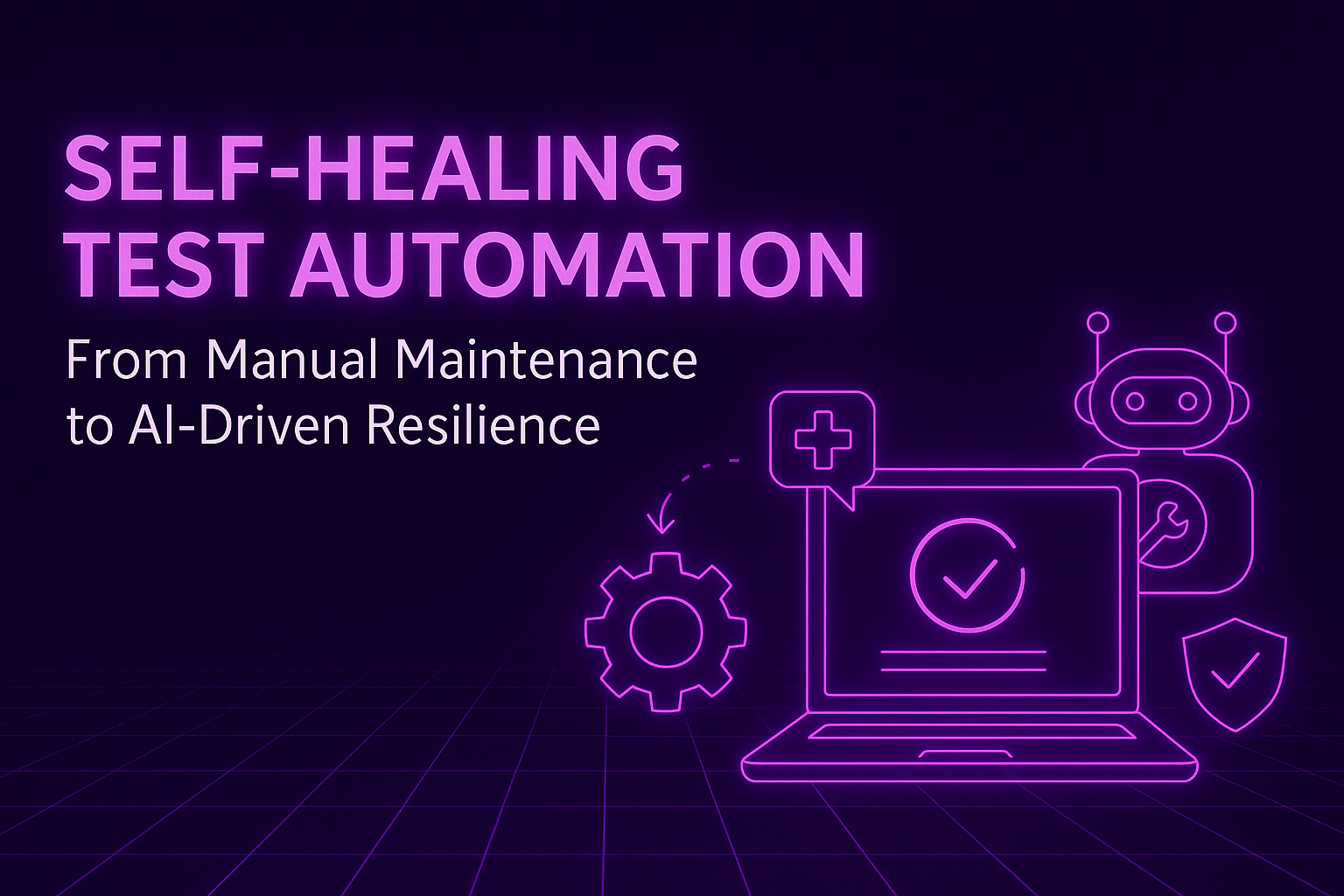Software testing has become increasingly complex and fast-paced. Traditional QA often break when applications change — for example, a button’s ID might be renamed, causing scripts to fail to locate it. Self-healing test automation solves this problem by giving tests the ability to automatically identify and repair issues when they occur.
In simple terms, self-healing frameworks monitor automated test execution, detect when an element or condition changes, and autonomously fix or adjust the test to continue running. Instead of failing when a locator is outdated, the test adapts using AI or rules-based logic to find the right element. This ensures continuous stability in CI/CD pipelines without constant manual intervention.
The Problem vs. the Solution
The Problem: Brittle Tests and Maintenance Overload
Traditional debugging, while powerful, comes with one major challenge: maintenance. Applications evolve — IDs, layout, and flows frequently change. Every time that happens, automated tests that rely on static locators break.
In many organizations, up to 70% of QA effort historically went into maintaining these broken scripts. Teams would pause development to fix selectors, update object repositories, or rewrite parts of test code. The result was slower release cycles, reduced confidence in automation, and mounting technical debt.
This cycle of constant maintenance led many teams to disable failing tests just to keep pipelines green, sacrificing coverage and code quality. The industry needed a smarter way, one where tests could evolve as the software did.
The Solution: How Self-Healing Test Automation Works
Self-healing automation uses intelligent algorithms to detect and correct failures. At its core, the process involves:
- Element Detection: The system identifies UI elements using multiple attributes — such as ID, text, XPath, position, or visual cues — not just a single locator.
- Failure Diagnosis: When a test fails to find an element, the framework analyzes the change, checking for similar attributes in the new version of the UI.
- Alternate Search: The tool uses fallback locators, text recognition, or even visual comparison to locate the right element.
- Automatic Correction: Once the matching element is found, the framework updates the locator or script automatically and retries the test.
Over time, the system learns from these adjustments, improving its ability to predict and heal similar issues in the future. This learning-driven approach minimizes false failures, increases resilience, and ensures tests adapt as applications evolve.
Self-Healing Test Automation: A Deep Dive
Pre-AI vs Post-AI: The Evolution of Self-Healing
Before the rise of AI, QA automation relied heavily on human-defined recovery rules. Engineers had to manually specify fallback locators or build error-handling logic into their frameworks. While helpful, these methods still required frequent manual updates whenever the UI changed significantly.
In the pre-AI era, test maintenance consumed about 30–40% of a QA team’s time. Defect leakage remained moderate to high, and test coverage confidence was low. Releases were often delayed due to broken scripts and manual QA.
The post-AI era transformed this landscape. AI-driven self-healing frameworks use machine learning to understand patterns in UI changes and predict correct element matches autonomously. The results are dramatic:
| Metric | Pre-AI Testing | Post-AI Testing |
|---|---|---|
| Test maintenance time | 30–40% of QA cycle | Under 10% of QA cycle |
| Defect leakage | Moderate–High | Significantly reduced |
| Release frequency | Monthly / Bi-weekly | Weekly / Daily |
| Test coverage confidence | Low | High |
| QA resource utilization | High | Stable or Reduced |
These shifts reflect a fundamental change: automation no longer breaks easily. Tests learn from past runs and recover from unexpected changes automatically, making QA cycles faster, more reliable, and more cost-efficient.
Benefits of Self-Healing Automation
The business and technical benefits of adopting self-healing test automation are substantial.
1. Reduced Maintenance Costs
By repairing broken tests automatically, self-healing systems cut script maintenance time dramatically. Many teams report 40–60% reductions in maintenance efforts, while others see savings as high as 85–95% over traditional systems.
2. Increased Test Coverage
With less time spent fixing scripts, QA teams can expand into automated test coverage across more features and platforms. This leads to more comprehensive testing and earlier defect and duplication detection, improving software quality.
3. Fewer False Failures
Self-healing minimizes “false alarms” caused by minor UI updates. AI-powered frameworks that leverage multiple identifiers and visual comparison report up to 80% fewer false failures, ensuring that test results reflect true issues, not noise.
4. Faster Feedback Loops
Because tests can automatically recover and continue running, teams receive immediate feedback during CI/CD cycles. This agility shortens release timelines and strengthens developer confidence in automation results.
5. Improved ROI
Over time, these efficiency gains translate directly into cost savings. Reduced manual intervention, faster test execution, and fewer release delays make automation more sustainable and profitable.
Industry Adoption and Real-World Impact
Self-healing test automation is no longer theoretical — it’s becoming a standard feature in modern QA ecosystems. Leading automation tools and low-code platforms now include built-in self-healing capabilities, enabling teams to scale testing without drowning in maintenance.
Companies implementing self-healing automation have reported:
- Over 90% reduction in UI-related test failures.
- Up to 75% drop in maintenance effort.
- Faster releases, shifting from weekly regressions to daily cycles.
- 62% time savings on routine QA tasks.
- 74% fewer false-failure reports, increasing confidence in automation outcomes.
These metrics show how AI-driven QA has matured from a helpful assistant to a strategic enabler. Self-healing automation is now seen as critical to sustaining rapid software delivery and continuous testing environments.
Why Self-Healing Matters for Future Modern QA
As organizations push toward continuous deployment, reliability and adaptability in testing are essential. Manual maintenance doesn’t scale when products are updated daily or even hourly.
Self-healing brings resilience to test automation. By combining AI-driven development, pattern recognition, and predictive recovery, it transforms testing from a fragile, reactive process into a robust, adaptive system.
This shift allows QA teams to focus on innovation over maintenance, coverage over cleanup, and strategy over firefighting, enabling true continuous testing that keeps pace with agile development.
Panto AI and the Future of Self-Healing
At Panto AI, we’ve taken self-healing automation a step further with our Vibe Debugging platform — an intelligent system that captures real-time execution data, context, and “vibes” across applications.
When a test fails due to a UI or logic change, Panto AI automatically diagnoses the issue, re-runs the affected steps, and updates the test flow without human input. The system leverages visual recognition, contextual understanding, and code-level insights to identify equivalent elements or actions.
For example, if a “Submit” button is renamed or moved, Panto AI understands the intent of that element and maps it correctly, ensuring the test continues seamlessly. Over time, the platform learns from these corrections, continuously improving its ability to self-heal across environments and devices.
This approach combines self-healing with context-aware debugging, creating an end-to-end AI QA automation workflow that’s faster, smarter, and more autonomous. Vibe Debugging enables developers and testers to spend less time fixing broken tests and more time improving product quality.
Self-healing test automation marks a turning point in the evolution of testing. As AI continues to advance, we can expect even greater autonomy in identifying, diagnosing, and fixing issues. Tests will eventually become fully adaptive systems capable of understanding intent, not just structure.
For teams striving for continuous delivery, the message is clear: embracing self-healing is no longer optional. It’s the foundation of sustainable, scalable and automated QA.






